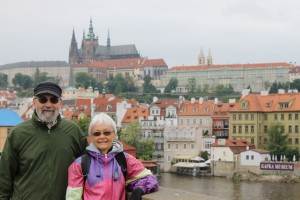Prague
From a youth hostel in Istanbul to a 5 –star hotel in Prague was quite a jump. Both places were good but very different!
The city of Prague is dominated by the Prague Castle, set on a hill overlooking the city and considered one of the biggest castles in Europe. It was begun in the 12th century and added to throughout the following centuries. It has been used as the seat of government almost ever since. It is vast; it is beautiful; it is full of tourists. The St. Vitus Cathedral, on the castle grounds, is seen towering above the castle walls. The windows were especially beautiful. We walked around a number of the buildings and heard outdoor music groups.
We visited the Jewish Quarter. The first Jews came to this area in the 10th century. During the 12th century the pope declared that Jews and Christians should not live together so their quarter was walled in and became a ghetto. In the 1780’s the Jews were given more freedom and the walls came down. Of the 120,000 Jews living in the area in 1939, just 10,000 survived the Holocaust. The various sites were quite moving and educational. One former synagogue had the names of 77,297 Czech Jews sent from here to the gas chambers. There was an exhibition of art drawn by Jewish children who were imprisoned at a concentration camp and later perished. Several other former synagogues had exhibits on Jewish traditions of death, religious practices, festivals, etc. We were not allowed to take photos in any of these synagogues. We did take photos at the Cemetery. We wandered through 12,000 tombstones. This area was the only burial ground allowed for the Jews of Prague. It is said that tombs are layered 7 or 8 deep.
One evening we attended an organ and trumpet concert in Church of St Nicholas in Old Town Square. We heard beautiful music of Purcell, Buxtehude, Bach, Telemann, Franck, and Handel. Afterwards we got some soup at a local pub where cartoons by a local artist are displayed on the wall.
We had several walking tours of different sections of the town, including walking across the Charles Bridge built in the 14th century. We had an hour boat ride under the Charles Bridge. We had an hour lecture on the history of Czech Republic; we won’t bore you with the details but for us, it helped us understand what we saw and what we heard.
We watched the Astronomical Clock strike on the hour. This clock was built in the 1400s. The clock shows both 24-hour time and modern time; it indicates times of sunrise and sunset; it shows the signs of the zodiac. At the top of the hour, two statues move, 12 apostles parade by, the rooster crows, and finally the hour is rung. We then enjoyed the traditional sausage, mustard, and bread for a lunch in the rain.
We took a tour outside of Prague to the Skoda Auto Museum and to the Sychrov Castle. Skoda cars, symbol of Czech pride, have been produced since 1895. The historic autos were quite interesting. The company reminded us of Ford in that it was begun to build cars cheap enough for the average person. They also produce/d bicycles, including fancy electric ones. Again they wanted the average person to be able to afford one so in the early years, they provided an option for the buyer to have the bicycle delivered to a pawn shop where the seller could get his money and the buyer could pay for it over time.
Sychrov Castle is a Neo-gothic manor owned for 125 years by the Rohans, a family of aristocrats who fled the French Revolution. It was confiscated by the Russians when they took over the country in 1948. We heard a lovely organ recital of Handel, Bach, and Dvorak in the manor chapel. Dvorak was a friend of the family and often came and played on this organ. We toured the lavish manor and ended with a good dinner in a restaurant on the grounds.
- Le Palais Hotel
- Prague Castle and St. Vitus Cathedral
- Prague Castle
- Prague Castle
- Musicians at Prague Castle
- St. Vitus Cathedral
- St. Vitus Cathedral
- St. Vitus Cathedral
- View of Prague from Castle
- Charles Bridge
- Near Jewish Quarter
- Old Jewish cemetery
- Church of St Nicholas
- Church of St Nicholas
- Church of St Nicholas
- Church of St Nicholas organ
- Pub
- Pub
- Pub artwork
- History lecture
- John Lennon wall
- View from Charles Bridge
- Musicians on Charles Bridge
- View from Charles Bridge
- Boat ride
- View from boat
- Astronomical clock
- Sausage and bread
- Enjoying sausage
- Enjoying sausage
- Skoda Museum
- Skoda Museum
- Skoda Museum
- Skoda Museum
- Sychrov Castle
- Sychrov Castle
- Marble floor tiles
- Sychrov Castle
- Parque floor
- Decorated ceiling
- Dinner at castle
- Dinner appetizer











































